“What Degas Might Have Done”
Peter Hastings Falk
“What Degas Might Have Done”
Peter Hastings Falk
“This essay proposes that if Degas is accepted as the undisputed master painter of dance, specifically ballet, then the subject's undisputed Master Sculptor is
Sterett-Gittings Kelsey”
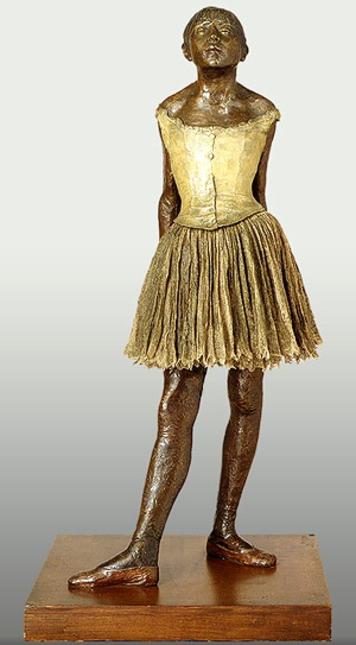
This is an in-depth critical treatise on the Kelsey bronzes, comparing them to those of Edgar Degas and other master sculptors of dance. Peter Hastings Falk is our leading Fine Art Historian, Curator, Fine Art Appraiser, Founder and Editor in Chief of Artnet.com ArtPrice.com AskArt.com and
Who Was Who in American Art
No artist in history is more synonymous with dance than the French Impressionist Edgar Degas {1835-1917}. In his brilliant compositions he captured the ballerina's intimate moments... and movements...from her practice halls to her performances at the Paris Opera. Many of his paintings and pastels of dance have rightfully achieved iconic stature. But it is important to point out that these paintings are finished products with a purpose entirely different from that of his sculptures. When Degas died in 1917 his family discovered more than 150 small figures in wax and clay in his studio. He had never exhibited them...with the exception of his famous "The Little Fourteen-Year-Old Dancer."
Nor did he conceive of enlarging his wax studies to monumental size as did Rodin, Carpeaux and other sculptors of his time. Nonetheless, just a year after his death, his estate authorized 72 of them to be cast posthumously as editions by the Paris Foundry Hebrard. Had they conferred with the master when he was living , he would have told them that his little wax studies of dancers were experimental...part of a grand process that, like his sketches, were meant to sharpen his visual acuity for capturing fleeting moments of graceful movement. He would have reminded them that even his photography served the same role as an aide memoire. And he would have told them that despite his blindness, from which he had been suffering gradually since the 1870's, he had found special joy in immersing himself in such a tactile process.
Dance sculpture for Degas was a very private exercise. Indeed, he intended for only a single one of them to be exhibited. Therefore, art historians must question the validity of grouping his paintings with what was originally a clandestine body of maquettes to serve together as the standard for the subject of dance. This begs the question: If Degas does
not lay rightful claim as the greatest sculptor of dance, who does? There have been many sculptors throughout history who have been inspired by dance but who among them had dedicated their lives to the subject and achieved excellence?
At this point it must be mentioned, that every art historian remains guarded about being accused of resorting to hyperbole. The temptation to interject even a single instance of it risks damaging a professional reputation. And in an art world whose very nature is imbued with subjective judgement historians constantly find themselves either averse to taking a stand of busily fortifying a defense that validates their positions.
But the world's historians and museum curators have already weighed in on history's greatest artists, further grouping them according to various thematic categories that combine period, style, medium, nationality, and subject matter... and many consensuses have been found. Indeed, college level art history textbooks, have reconfirmed the principle of consensus, as have those many books and exhibition catalogues focusing on specialized categories. However, there is one special medium-subject combination that has never received thorough academic treatment: dance and sculpture.
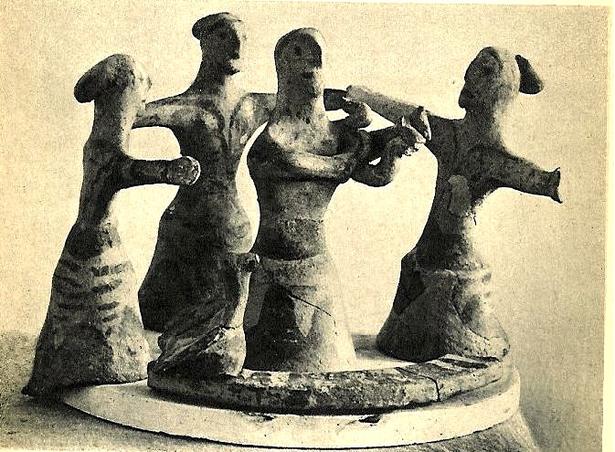
Art history abounds with magnificent examples of dance sculpture. Among the earliest are those terra-cotta figures created by the ancient Minoans thirty-six hundred years ago. Twenty-two hundred years ago, sculptors of Classical Greece captured sacred dances and Dionysian rites in clay and marble. And caves in Orissa, India, have revealed sculptures of Odissi dance from the same period, which are a graceful and spiritual fusion of dance and sculpture. But one would be hard-pressed to find an artist who has dedicated most of his or her life to the subject of dance....and even harder-pressed to find one who has focused upon ballet as has Kelsey.
The search would begin in 1669 with Louis XIV's founding of the Paris Opera. Later, during the Romanticism of the eighteenth century, ballet evolved as an art form in its own right. But it was not until the mid nineteenth century when ballerinas, dancing in tutus on their tip-toes, displaced male dancer in the spotlight.
And when Charles Garnier's new Paris Opera finally opened in 1875, Degas intensified his quest to capture the movement and gestalt that is unique to ballerinas. By the time he exhibited his "The Little Fourteen-Year-Old Dancer" with the Impressionists, in 1881, the Imperial Ballet School of Saint Petersburg had displaced Paris as the center of the dance world. It took a revolution brewing in Russia to relocate the Ballets Russes to Paris, and throughout the 1920's the company thrived under the direction of Diaghilev. This modern era of dance imposed new, strict training regimens and exacting body proportions, which were required to execute demanding performances. The dancer's bodies and costumes that were captured by Degas in the last quarter of the nineteenth century had vanisheed before the end of his life.
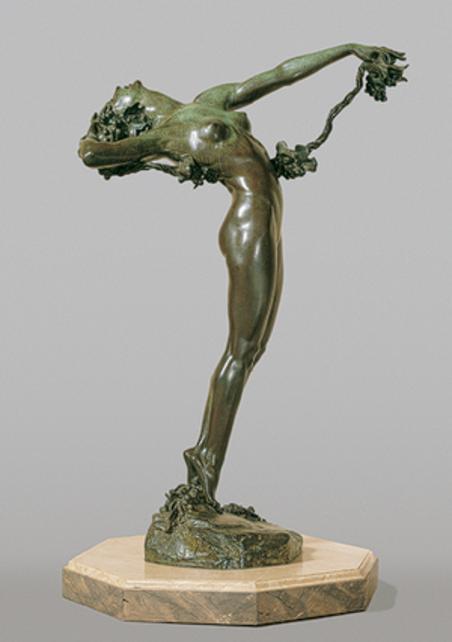
Amidst the next generation of American sculptors who came to Paris, there were four women who attempted to capture the Russian dancer in bronze. Harriet Whitney Frishmuth {1880-1980 } won early recognition for her portraits of Anna Pavolva. Both sculptors had studied with Rodin. Bessie Potter Vannoh { 1872-1955 } created a few rhythmical bronzes, the best of which is a dancer in a full flowering gown. Janet Scudder { 1869-1940 } also created a few dancing figures. While all four of these very talented women sculptors, brilliantly expressed the movement of dance in bronze during the 1910's-1920s, their involvement with ballet was at best either brief or tangential. Frishsmuth stands out as the most accomplished in expressing elegant movement while Hoffman focused more on the sculpted portrait. Both Vonnoh and Scudder found success with their bronzes by concentrating on children, figures for fountains , gardens and portrait commissions.
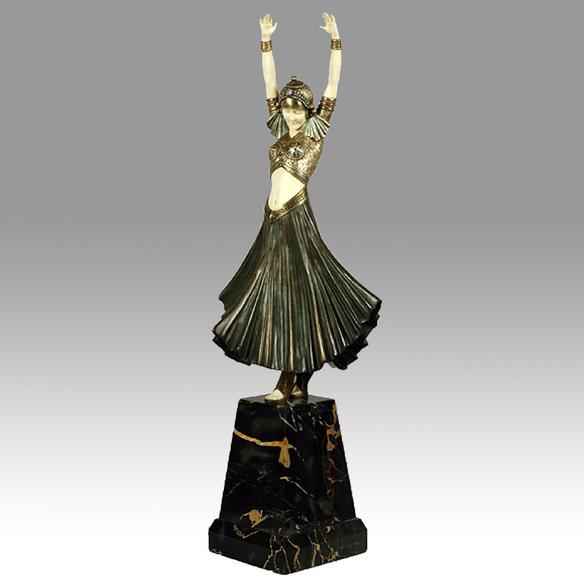
Emerging during the 1880s and successful through the early twentieth century was the great triumvirate of American male sculptors: Augustus Saint-Gaudens {1848-1907 }, Daniel Chester French {1850-1931 and Frederick Mac Monnies {1863-1937 }. While each of these men could effectively express movement in their bronzes, none of them considered dance.... particularly ballet...as a subject that stimulated their visual exploration. In Paris only one male sculptor, Demetre Chiparus {1886-1947 }. stands out for his sculptures of the ballet. In a distinctive Art Deco style, he combined ivory with cast bronze to produce many sculptures inspired by the dancers of the Ballet Russes.
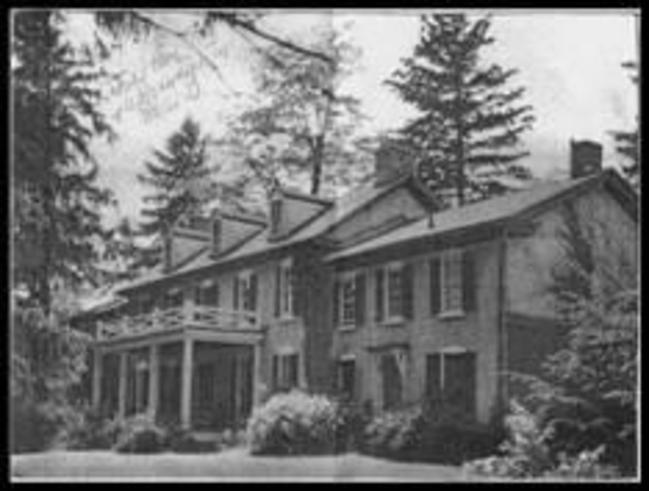
It seems as if Sterett-Gittings Kelsey, had already been destined to become America's "sculptor of dance." She and her twin sister, Easy, were raised on their grandparents' 350-acre farm, "Bacon Hall" in the bucolic countryside of Glencoe, Maryland, north of Baltimore. It was a child's dream world. The stream passing through the farm was lined with gray clay in which the little hands of Kelsey delighted in fashioning the pots and plates. And she was born in 1941, the year of Balanchine's premier of his ballet, Tchaikovsky Piano Concerto No. 2. The year after Chiparus died, a seven-year-old American girl fell in love with ballet when she attended a birthday party at "Red Oaks," the magnificent Victorian home of Katherine Phillips Rutgers in Greenwich, Connecticut. Here she discovered an exquisite collection of little porcelain ballet dancers. Mrs. Rutgers, who had been a world-class ballerina, explained the stories behind each of the porcelain dancers. She then brought the transfixed girl to her ballet studio on the third floor, which was filled with costumes from the many ballets in which she had danced.
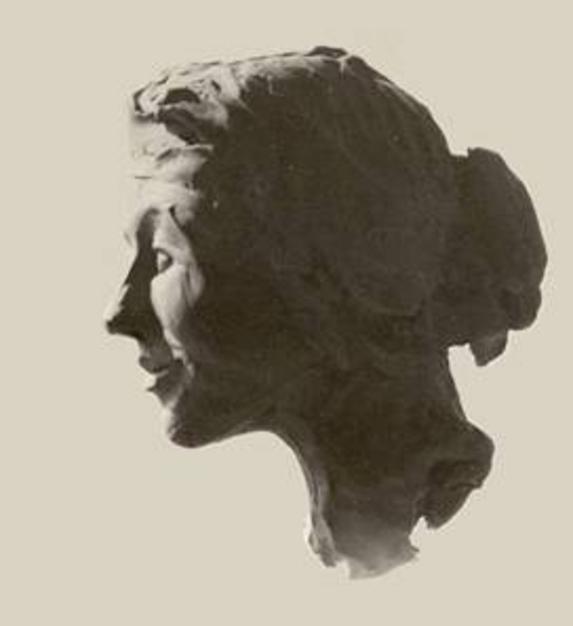
Her first sculpture: Garrison Forest School in Maryland
When the family moved to Greenwich in 1947, the sisters took their first pony-riding classes and subsequently competed in the National Horse show over the years until they went to college. Thus began a life-long fascination with the controlled graceful movements in both dancing and riding. If her childhood play with clay from the banks of a stream sparked her first pleasure in creating three-dimensional forms, it was an art instructor at the Garrison Forest School, Margaret Rice, in Maryland who was the catalyst for her addiction to sculpture. Working in Plasticine, the non-drying clay, she created her first figure on an armature.

Returning to Greenwich in 1956, she spent her final two years at the Rosemary Hall School where she studied under the accomplished octogenarian painter, Julius Delbos {1897-1970}. She and her sister took private lessons in ballet from dancer-choreographer Felicity Foote who had studied modern dance in Europe. From 1960-1964 Kelsey attended the Rhode Island School of Design where the discipline learned from an intense anatomy class under Michael B. Mazur { 1935-2009 } left a lasting impression. She studied sculpture under John Bozarth and Thomas Morin. In 1962 Morin's class built the school's first furnace for casting, which was complete after several weeks. The experience of casting her first bronze, had her hooked! The capture of movement remained her focus and in the summers of 1963 and 1964 she choreographed with Felicity Foote, who had further established herself by founding the Greenwich Ballet Workshop in 1960. Kelsey created a light show that began with the shadows of her sculptures of dancers. The shadows then moved in synchrony with the live dancers and each performance ended with the live dancers in the same position as the shadows of her sculptures.
After graduation from R.I.S.D. Kelsey married Bowie Duncan, who taught English at the Wilbraham Academy in Massachusetts. A son was born in 1966 and a daughter in 1968. However, a calamity in the form of a very rare and usually fatal Salmonella D meningitis threatened the life of her infant daughter for more than a year. Miraculously, the baby survived. Having endured this nearly tragic experience, Kelsey returned to sculpture more determined and impassioned than ever. Reflecting upon the vigilance and discipline imposed by her baby's bumpy yet miraculous recovery, Kelsey noted, "I doubt that I could have become a sculptor had it not been for Salmonella D. All of my education would not have been used in any meaningful way.
Without having learned a new work ethic I call "the freedom of discipline" these works would never have been produced. Of this I am certain. There are many parts and pieces that must come together to make a sculptor but for me the most important ingredient was discipline."
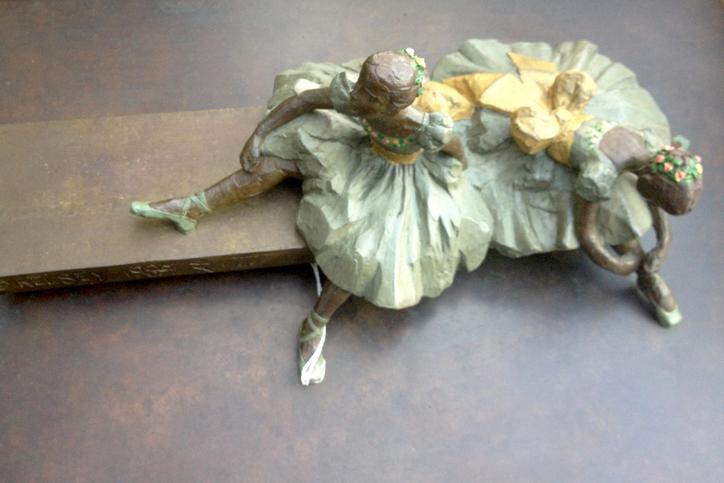
That discipline included the study of dance, choreography, and music through what became a large archive of videotapes of ballet and movies about dance. Certainly, the spontaneity of playing with wax or clay remained just as important a part of her “sketching” process as it was for Degas. “Much of the creativity comes from these little sketches but a finished work is like moving from a single melody line to a full symphony,” she says. And moving to that symphony meant choosing to replay the video cassette recorder over and over — a discipline that provided a newly-focused way of capturing motion as well as learning about film production, choreography, and set design. Soon, her past training with dance teachers, choreographers, musicians, sculpture professors, and even pony-riding instructors became integrated as an innate sense for capturing motion. “My sculpture would come from this acquired library of sounds and images, which scrambled themselves into my head, and then found their way to my hands,” she says. “I was determined to try to capture movement in my work and somehow make it sing.” Numerous films of movies and dance continued to serve as catalysts for new works. For example, in 1981 at age forty she produced two of her favorite sculptures after studying the masterful choreography of Choo San Goh in his ballet, "Configurations," which was commissioned by Mikhail Baryshnikov for the American Ballet Theater and set to the music of Samuel Barber’s piano concerto. “It took my breath away!” she exclaimed.
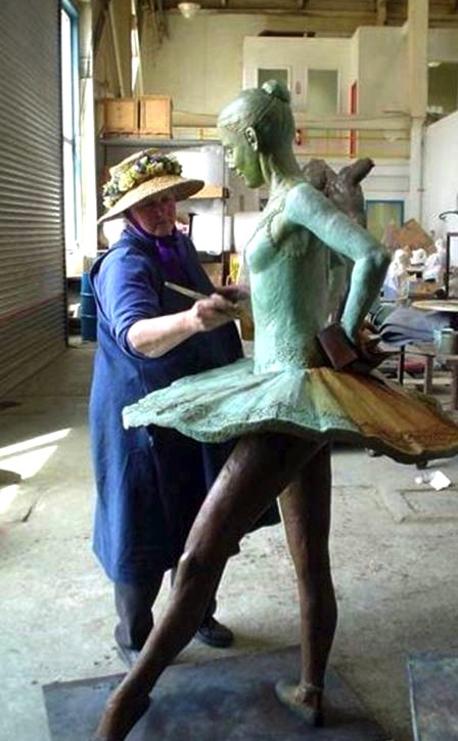
Equally important has been Kelsey's technical understanding of every step in the process of creating a bronze, from clay to molds, casting, finishing and patination. For example, while creating the original figure in clay, she is acutely aware of the need to compensate for the inevitable shrinkage found in the final bronze casting. Her early works were cast at the Rennaissance Fine Art Foundry in Noroton, Connecticut. Since 1971 the Polich Tallix Fine Art Foundry in Rock Tavern, New York.. known for having produced bronzes for Willem de Kooning, Frank Stella, Roy Lichtenstein, and other masters... has cast most of her bronzes.
In 1966 Royal Copenhagen of Denmark desired to produce a new series of sculptures expressing different types of figural movement. In there quest to find that singular master sculptor, they held international competitions. Seven years later in 1973, they finally found Kelsey. She embarked on a three year commission, first producing fourteen porcelain figurines of children and ballerinas... and purposefully depicted the young girls dancing incorrectly in the naivete. Next she produced eight dance figures cast in bronze, in limited editions of five-hundred. They sold out within forty eight hours of their release. Her third contract resulted in twelve more limited editions in bronze, this time focusing on sports such as fencing , tennis and skating, gymnastics and soccer. In order to fully understand each sport's movement, she was instructed by a champion in each sport such as Olympic cross-country skier Bill Koch and Olympic skater Dorothy Hamill.
Throughout her career, Kelsey has consistently maintained the same enthusiasm for capturing lyrical movement in both humans and animals. However, ever since she was a starry-eyed seven-year-old, encountering ballet in Mrs. Rutger's attic studio, it is the movement unique to modern ballet that has exerted from her the most assiduous commitment. She does not focus on the sequential positions.. First, Second , Third, Fourth and Fifth...with which all balletomanes are intimately familiar. For Kelsey, those positions are basically stationary and lack of perceived movement. Rather, she captures most of her figures in those moments just before or just after these positions. Like Cartier-Bresson photographing " decisive moment," this decision is what brings life to her dancers.
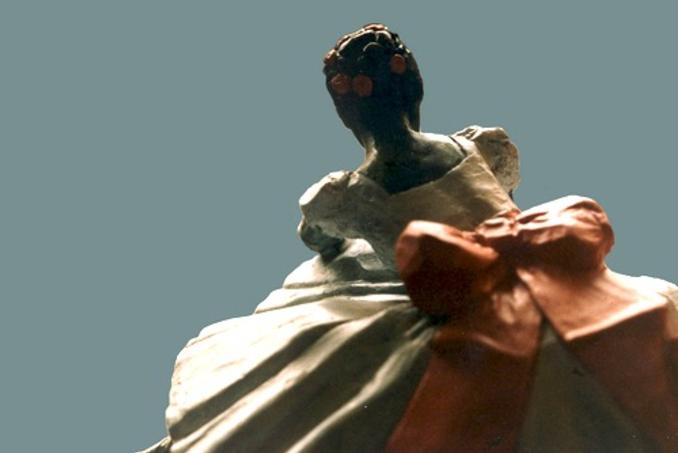
If Degas had more fully developed many more of his small clay or wax figures to the same final stage as he did his famous "The Little Fourteen-Year-Old Dancer," he would doubtlessly have achieved the same strong gestalt for dance that makes his paintings and pastels such masterpieces. But as that was never his intention, the collection of his dance sculpture... all experimental maquettes... save one...cannot reasonably be invoked as the standard for dance sculpture. That honor must be conferred upon Sterett-Gittings Kelsey
